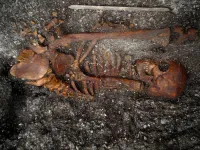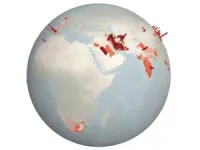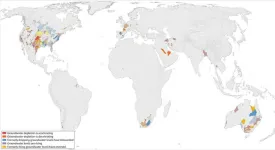(Press-News.org) Researchers at the Universities of Basel and Zurich have discovered the genetic material of the pathogen Treponema pallidum in the bones of people who died in Brazil 2,000 years ago. This is the oldest verified discovery of this pathogen thus far, and it proves that humans were suffering from diseases akin to syphilis – known as treponematoses – long before Columbus’s discovery of America. The new findings, published in the scientific journal Nature, call into question previous theories concerning the spread of syphilis by the Spanish conquistadors.
The history of the emergence and spread of infectious diseases was of great importance for global health even before the Covid-19 pandemic. With modern laboratory methods, researchers can now detect the tiniest traces of DNA from pathogens in prehistoric finds. That means they can trace back how these pathogens spread historically and their evolutionary development.
An international research group led by Professor Verena Schünemann from the University of Basel, formerly at the University of Zurich, in collaboration with ETH Zurich and the Universities of Vienna and Sao Paulo, examined prehistoric bones belonging to four individuals who died 2,000 years ago in the coastal region of Santa Caterina in Brazil. For some of the individuals visible pathological changes to the prehistoric bones were detected which could indicate that the deceased were suffering from an illness similar to syphilis.
Prehistoric DNA from bones dating over 2,000 years old
The researchers used dentists’ drilling tools to remove minuscule samples of bone under sterile conditions. From those samples they isolated prehistoric genetic material (ancient DNA) belonging to the syphilis pathogen. Their study, published in the renowned scientific journal Nature, demonstrates that all the bacterial genomes that have been investigated can be attributed to the Treponema pallidum endemicum strain – that is, the pathogen that leads to bejel.
Treponematoses are a group of infectious diseases that includes the sexually transmitted disease syphilis. While syphilis as a venereal disease presents a global health risk, bejel, which is spread by skin contact, only occurs today in very arid regions of Africa and Asia.
“Our study has been able to show that endemic syphilis was already present in humid zones of Brazil around 2,000 years ago,” says Schünemann. This means that people were already becoming infected with endemic syphilis, probably via skin contact, more than 1,000 years before the arrival of Columbus in the New World.
Syphilis-like diseases originated pre-Columbus
Intense debates are still ongoing today among specialists and medical historians concerning whether Christopher Columbus’s sailors and soldiers brought sexually transmitted syphilis from the New World to the Old upon their return in 1492. The illness spread rapidly from the end of the 15th century onwards, particularly in harbor towns.
“The fact that the findings represent an endemic type of treponemal diseases, and not sexually transmitted syphilis, leaves the origin of the sexually transmitted syphilis still unsettled,” says Kerttu Majander, postdoctoral researcher at the University of Basel and one of the lead authors of the study. However, the authors consider that there is a lot to suggest that treponematoses were already widespread in Europe before Columbus’s time.
“As we have not found any sexually transmitted syphilis in South America, the theory that Columbus brought syphilis to Europe seems to appear more improbable,” agrees Schünemann. In point of fact, earlier discoveries by her group, for example in Finland and Poland, suggest that some forms of treponematoses already existed in Europe too.
Recombination could have driven the development of syphilis-like diseases
Many species of bacteria exchange traits that are of evolutionary benefit via what is known as horizontal gene transfer, or recombination. A comparison between the prehistoric DNA in the bones from Brazil and today’s pathogens shows that such recombination events have indeed taken place. “We cannot pinpoint exactly when this exchange took place, but it is probably one of the driving mechanisms in the divergence between the subspecies that cause different treponemal infections,” says Marta Pla-Díaz of the University of Basel, the other lead author of the study.
The DNA comparison also allows the date of the Treponema pallidum family’s emergence to be deduced. Their investigations show that these pathogens have arisen at some point between 12,000 and 550 BCE. The history of these pathogens therefore stretches much further back than previously assumed.
“Although the origin of syphilis still leaves room for imagination, at least we now know beyond a doubt that treponematoses were no strangers to the American inhabitants who lived and died centuries before the continent was explored by Europeans,” concludes Schünemann. She and her team are confident that advances in the analysis of prehistoric DNA could also lead to the discovery of the origin of venereal syphilis.
END
Syphilis-like diseases were already widespread in America before the arrival of Columbus
2024-01-24
ELSE PRESS RELEASES FROM THIS DATE:
Global groundwater depletion is accelerating, but is not inevitable
2024-01-24
(Santa Barbara, Calif.) — Groundwater is rapidly declining across the globe, often at accelerating rates. Writing in the journal Nature, UC Santa Barbara researchers present the largest assessment of groundwater levels around the world, spanning nearly 1,700 aquifers. In addition to raising the alarm over declining water resources, the work offers instructive examples of where things are going well, and how groundwater depletion can be solved. The study is a boon for scientists, policy makers and resource managers working to understand global groundwater dynamics.
“This study was driven by curiosity. We wanted to better understand the state of global ...
Targeted scientific research projects to demonstrate effectiveness of ‘food is medicine’ in health care
2024-01-24
DALLAS, Jan. 24, 2024 — In an effort to identify effective food is medicine approaches for incorporating healthy food into health care delivery, the American Heart Association, the world’s leading voluntary organization focused on heart and brain health research, now celebrating 100 years of lifesaving work, today announced grants totaling $7.8 million to 19 research projects nationwide as part of its Health Care by Food™ initiative.
The research projects focus on areas including food resource coaching for patients of a safety-net clinic, delivering food is medicine interventions ...
Mass General Cancer Center announces first recipients of Krantz Awards for Cancer Research
2024-01-24
The Krantz Family Center for Cancer Research at the Mass General Cancer Center today announced the selection of 17 scientists who have been awarded a combined $6 million in funding. These competitive awards, which will be granted annually, were established to recognize the trailblazing efforts of Krantz Center scientists and accelerate ideas, projects and initiatives with the potential to fundamentally change how cancer is diagnosed and treated.
Philanthropists Jason and Keely Krantz, who ...
A large percentage of European plastic sent to Vietnam ends up in nature
2024-01-24
Despite strict EU regulations on plastic recycling, there is little oversight on plastic waste shipped from the EU to Vietnam. A large percentage of the exported European plastic cannot be recycled and gets dumped in nature. That is what new research led by Utrecht University’s Kaustubh Thapa has found.
Following the recycling path
About half of Europe’s plastic waste is exported to a number of countries in the Global South, including Vietnam. A Dutch and Vietnamese research team ventured to Minh Khai Craft Village, the largest recycling hub ...
A year of breakthroughs from Cincinnati Children’s
2024-01-24
Cincinnati Children’s continues to be a cradle for great discoveries.
Our latest Research Annual Report, online now, recounts a remarkable year of scientific advancement supported by a record-high level of research funding from federal, state, industry and philanthropic sources.
Among the many accomplishments from more than 1,000 faculty working in 50 research areas:
Promising results from the world’s first clinical trial of FLASH proton therapy for cancer treatment
Developing the first intestine organoids with functional immune cells, a major step closer to testing potential treatments using these amazing lab-grown tissues
Completing ...
AMS Science Preview: The “Black Swan” heatwave; volcanic chillers; tornadogenesis
2024-01-24
The American Meteorological Society continuously publishes research on climate, weather, and water in its 12 journals. Many of these articles are available for early online access–they are peer-reviewed, but not yet in their final published form.
Below is a selection of articles published early online recently. To view full article text, members of the media can contact kpflaumer@ametsoc.org for press login credentials.
Searching for the Most Extreme Temperature Events in Recent History
Bulletin ...
Ultrasounds can help predict the risk of preterm births, new research shows
2024-01-24
Researchers have developed a way to use ultrasound to predict whether a pregnant person is at risk of delivering a baby prematurely, which occurs in upward of 10% of pregnancies in the U.S.
The new method — the result of more than 20 years of collaboration between researchers in nursing and engineering at University of Illinois Chicago and University of Illinois Urbana-Champaign — measures microstructural changes in a woman’s cervix using quantitative ultrasound. The ultrasound method works as early as 23 weeks into a pregnancy, according to the research, which is published in ...
Exposure to flame retardants linked to premature birth, higher birth weight
2024-01-24
(SACRAMENTO, Calif.) — In the largest study of its kind, researchers at UC Davis Health found that exposure to organophosphate ester flame retardants during pregnancy was associated with preterm birth, especially among females. The chemicals were also linked to higher birth weight, a concern for increased obesity risk. The major new research study was published in Environmental Health Perspectives.
“The importance of this study lies in unraveling the potential impact of exposure to environmental chemicals during pregnancy on fetal development. Our findings guide our understanding of how these chemicals may be silently seeding lasting challenges ...
How a protein fights off bacteria
2024-01-24
The human immune system is constantly fending off a wide range of invaders – a feat that requires a diverse array of cellular troops and molecular weaponry. Although a great deal is already known about immune defense cells and the strategies they employ, many molecular details have remained elusive. Now a research team led by Professor Oliver Daumke, a lab head at the Max Delbrück Center, has managed to unravel the main activation mechanism of GBP1, a protein that plays a pivotal role in combating certain bacteria. They report in “The EMBO ...
Breakthrough technology offers promising treatment for ischemic retinopathy
2024-01-24
A groundbreaking technology with immense potential in treating ischemic retinopathy in premature infants and diabetic patients has been developed by Professor Byoung Heon Kang and his research team in the Department of Biological Sciences at UNIST, in collaboration with Professor Dong Ho Park’s team at Kyungpook National University Hospital. Ischemic retinopathy, characterized by the breakdown of the blood-retinal barrier and abnormal blood vessel growth, often leads to vision impairment and loss. The researchers have identified the critical role of a mitochondrial ...







